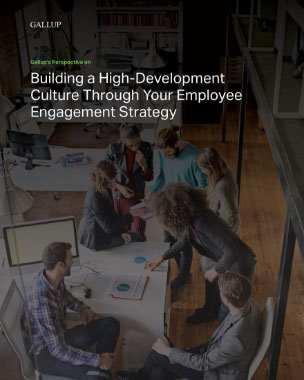Story Highlights
- Employees now look to their workplace for purpose and development
- Companies that create a high-development culture achieve high performance
- Learn ways to improve work performance by implementing employee development strategies
You've heard of high-performance workplaces, but how do they become "high-performance"?
Gallup has discovered that one of the most important factors in creating a high-performance workplace is instilling a high-development culture: one that values the growth of individuals.
Organizations that have made a strategic investment in employee development, Gallup finds, report 11% greater profitability and are twice as likely to retain their employees.
It makes sense. High-achieving people (the ones who can grow your company) seek development. And all employees have a psychological need to learn and grow as human beings. Development at work satisfies two of the five essential elements of wellbeing by fulfilling a person's drive for career and social wellbeing. Having a sense of purpose makes people feel great about what they do at work and helps them enrich and deepen their relationships outside of it.
- Nearly nine in 10 millennials say professional development or career growth opportunities are very important to them in a job.
- "Career growth opportunities" is the No. 1 reason people give for changing jobs.
People need to be connected and involved in their workplace, and they want to be when that workplace offers them not only purpose, but also employee training and development.
How to Create a High-Development Culture
Creating a high-development culture means more than adding a few learning programs and employee development plans to the roster. Here are four strategies that set the highest-performing workplaces apart:
1. They protect their investment in employee development with a focus on increasing employee engagement. Many leaders fear that they will invest in their employees' development only to see them walk out the door anyway. This does happen -- but the best way to keep it from happening is to secure people's psychological commitment through an employee engagement strategy.
Organizations can foster commitment and improve engagement by meeting employees' basic needs with clear expectations, sincere recognition, the right materials and equipment -- and the rest of the 12 elements we outline in our employee engagement practices.
People won't stay with an organization or perform at their best -- even if they're given lots of development and learning opportunities -- if they're not engaged in their work and committed to the company.
2. They avoid the most common misunderstanding about development. Companies have typically defined growth and development as a promotion. While effective development may involve a promotion, it doesn't have to. Often, the employees who are really good at what they're currently doing don't necessarily want to be promoted -- but they still want growth.
From Gallup's extensive workplace research, development should primarily be:
A process of understanding each person's unique talents (naturally recurring patterns of thought, feeling or behavior that can be productively applied) and finding roles, positions and projects that allow them to combine their talents and abilities with experiences to build strengths (the ability to consistently provide near-perfect performance in a specific activity).
Giving people the opportunity to understand themselves, develop what they're good at and use their strengths every day at work can be more fulfilling than a new title for most of your employees.
Gallup research shows that when employees know and use their strengths, they are more engaged (nearly six times more), have higher employee performance and are much less likely to leave their company.
3. Their managers are highly involved in the development of individuals -- they act as coaches, not bosses. The manager is the vessel that makes culture change and engagement a reality. Managers are closer than HR or leadership to employees' daily realities, so they're more likely to understand how to develop employees and engage them.
And since people are more likely to learn and grow when they receive immediate feedback that is specific and targeted to their development, managers become the perfect people to coach employees and link them to practical learning and action.
4. Their leadership owns the culture change (not HR alone). Culture change does not happen through all-hands meetings, emails, newsletters and strategy retreats. Consistent communication does help. But the fundamental driver of culture change is commitment from leadership to high-performance workplace practices that is backed by their actions.
When C-level officers model a focus on development and put resources toward it, managers and employees will begin to mimic that focus on their own. This behavior change is foundational to making culture change stick.
The Best Employees Will Always Seek Development
A focus on developing people has the potential to outperform practices like Six Sigma in creating organic growth for companies. High-achieving employees continuously seek purpose and development -- so if they're engaged at your company and you provide those growth and development opportunities, they won't have a reason to leave, and you'll attract even more top talent.
It's a powerful opportunity for companies to capture the loyalty of hardworking employees who want to invest in their future and the future of your business.
Start creating a high-development culture today:
- Make sure you’re getting the basics of employee engagement right.
- Learn what Gallup recommends for a transformative learning and development strategy for your company.
- Get our bestselling book, It's the Manager, to learn more about how managers play a key role in creating your ideal culture.




